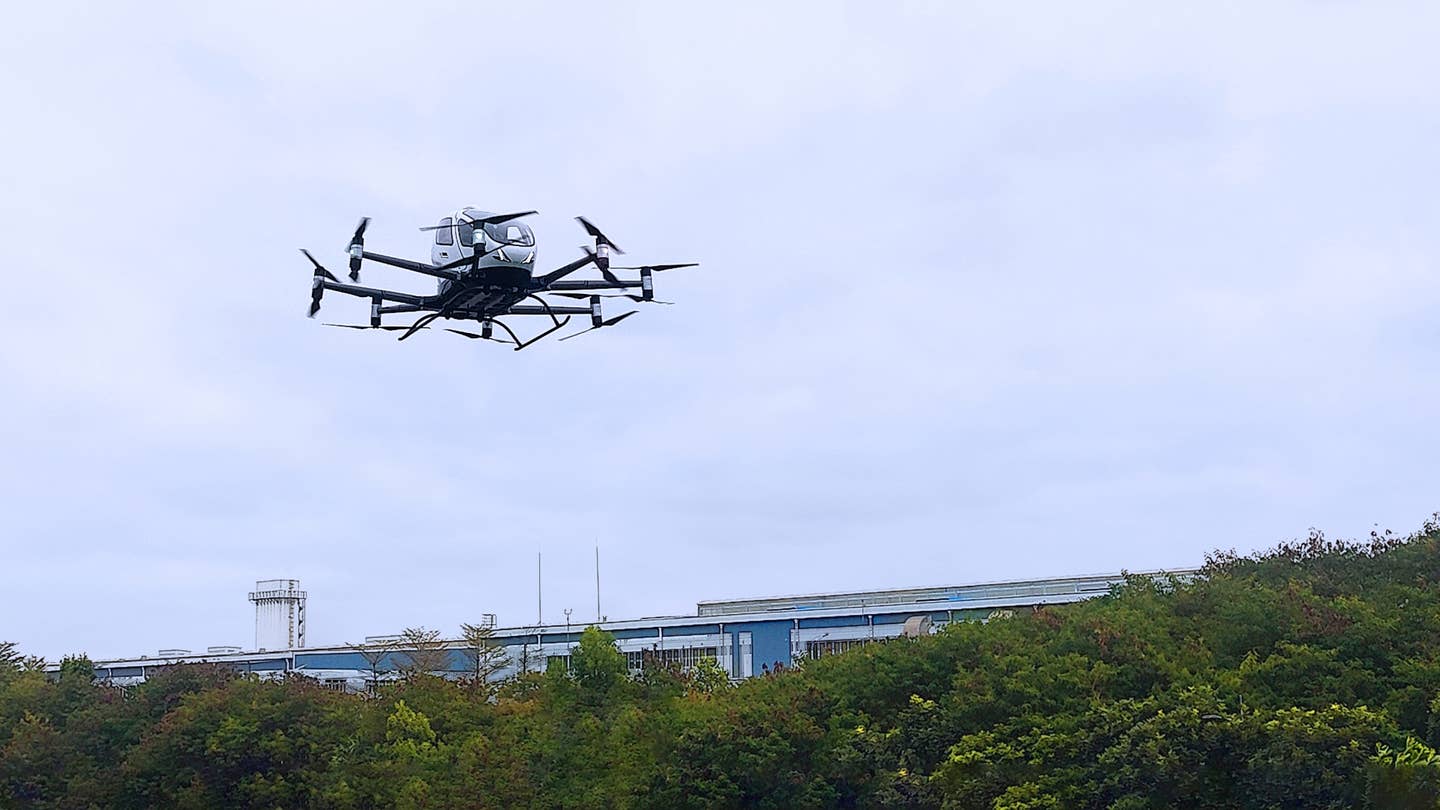EHang Begins Delivering Air Taxi to Customers Following Airworthiness Certification
The Chinese manufacturer’s EH216-S air taxi was the first in the world to receive type certification from a national regulator.

EHang’s pilotless EH216-S air taxi makes a demonstration flight at a ceremony ringing in the company’s first commercial delivery. [Courtesy: EHang]
American lawmakers and regulators have big plans for electric vertical takeoff and landing (eVTOL) air taxis. But China continues to look like it will be the first country in the world to introduce high-flying urban air mobility (UAM) services to the public.
Chinese manufacturer EHang—which a few months ago became the first company to obtain type certification for an eVTOL air taxi design—said it has now obtained airworthiness approval for its self-flying EH216-S model, clearing the way for a commercial launch in the coming months.
The firm also delivered its first air taxi to a customer: Eton, an intelligent aviation technology subsidiary of Guangzhou Development District Communications Investment Group Co. That company is managed by the local government of the Huangpu District in Guangzhou, where EHang is based.
“Today, we have set another milestone with the first AC for pilotless passenger-carrying eVTOL aircraft and started commercial delivery of the certified EH216-S to our customer,” said Huazhi Hu, founder, chairman, and CEO of EHang. “In the near future, we anticipate an increasing number of aircraft rolling off from our production line to gradually fulfill our backlog orders, thereby serving more customers and passengers.”
The EH216-S—which has a 22 sm (19 nm) range, 80 mph (about 70 knots) cruise speed, and 485-pound payload—will be used for passenger transport, as well as tourism, logistics, and medical use cases.
EHang says its airworthiness certification from the Civil Aviation Administration of China (CAAC) is, like its type approval, the first of its kind. The certificate is the regulator’s endorsement that the EH216-S complies with the approved type certificate and meets the safety and quality requirements for commercial operations over bustling cities. It also validates the company’s manufacturing capabilities, test flights, quality assurance, and product management.
Now, at least one approved model is in the hands of Eton, which plans to launch operations across the Guangzhou district. Guangzhou is one of three cities—the others being Shenzhen and Hefei—with which EHang has locked down strategic partnerships for future services in the low-altitude economy, CAAC’s equivalent term for UAM.
“We are very optimistic about our upcoming commercial operations of aerial tourism in Guangzhou and the bright future of our business cooperation with EHang,” said Chengjiu Zhou, general manager of Guangzhou Development District Communications Investment Group Co. “With EHang’s leading-edge, safer, greener, more efficient and certified passenger-carrying UAV solutions, as well as robust local government support in infrastructure and investment, we look forward to spearheading the development of the local low-altitude economy.”
There is little publicly available information about China’s certification process for eVTOL. But in a 2022 interview with Vertical magazine, an agency official explained that China, unlike the U.S., will first certify autonomous or remotely piloted designs before turning to aircraft with an onboard pilot. EHang and main competitor AutoFlight each fit the bill.
Following the creation of a strategic partnership with the Shenzhen Bao’an District Government in July, EHang on Tuesday announced the two will launch a UAM Operation Demonstration Center in Shenzhen’s OH Bay. Meanwhile, the manufacturer signed a letter of intent with Bao’an Transportation Group to create a model for autonomous electric air taxi operations, with an eye toward building a low-altitude economy in Shenzhen.
The center, which was built in just four months with support from the local government, covers nearly 50,000 square feet and includes an eVTOL vertiport, hangars, command-and-control center, service center, passenger waiting area, and other amenities. Following its opening, EHang completed a demonstration flight out of the site for government officials, regulators, business representatives, and regular citizens.
Also on Tuesday, the manufacturer announced that customer Shenzhen Boling Holding Group Co.—which purchased five EH216-S units and plans to snap up 95 more in the future—established a subsidiary and joint venture with EHang called Shenzhen Pengcheng Wings General Aviation Co. The company will become a UAM flight services operator and collaborate with third parties to bring electric air taxis to Shenzhen.
“Starting from the UAM Operation Demonstration Center at OH Bay, we look forward to carrying out services with EH216-S and pioneering low-altitude operational demonstration cases that will extend to the entire Shenzhen region and even the Guangdong-Hong Kong-Macao Greater Bay Area,” said Guanshen Xu, chairman of Pengcheng Wings.
While EHang has not yet made plans for the U.S. market, the company is looking beyond China.
Earlier this month, it signed a deal with an Emirati operator to bring air taxis to the United Arab Emirates in 2024. The agreement calls for the purchase of 100 aircraft with deliveries beginning in 2024. EHang will also join the UAE’s Smart and Autonomous Vehicle Industry (SAVI) Cluster, a development hub of which U.S. manufacturers Archer Aviation and Joby Aviation are also members.
The firm is also targeting operations in Europe. In November, it announced plans to build a first-of-its-kind European UAM Center at Spain’s Lleida-Alguaire International Airport (LEDA). The center aims to prepare mainland Europe for UAM services by collecting data on early operations, which will be used to integrate eVTOL services with airport infrastructure, air traffic management systems, and other technologies.
Those services will move closer to reality once EHang obtains a production certification, which will greenlight it to begin manufacturing its type-approved design. After that, the company will need to coordinate with various local regulators to validate its approvals in other countries, clearing the path for international expansion.
Like this story? We think you'll also like the Future of FLYING newsletter sent every Thursday afternoon. Sign up now.

Sign-up for newsletters & special offers!
Get the latest FLYING stories & special offers delivered directly to your inbox






